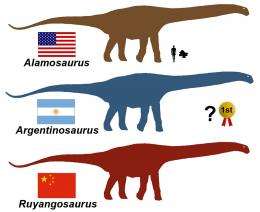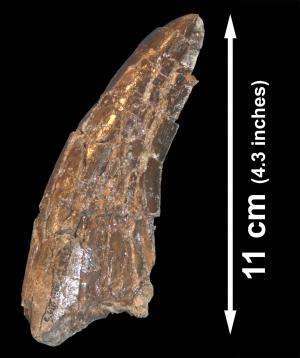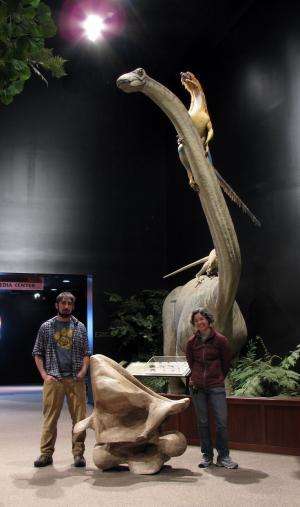New study reveals North America's biggest dinosaur

(PhysOrg.com) -- New research from Montana State University's Museum of the Rockies and the State Museum of Pennsylvania has unveiled enormous bones from North America's biggest dinosaur.
In a paper published Dec. 6 in Acta Palaeontologica Polonica, MSU researcher Denver W. Fowler and coauthor Robert M. Sullivan from Harrisburg, Pa., describe two gigantic vertebrae and a femur that the team collected in New Mexico from 2003 to 2006. Carrying the vertebrae alone took most of a day and was a "killer" because the paleontologists carried them 1.2 miles through 100-degree heat, Fowler said.
The bones belong to the sauropod dinosaur Alamosaurus sanjuanensis: a long-necked plant eater related to Diplodocus. The Alamosaurus roamed what is now the southwestern United States and Mexico about 69 million years ago.
"Alamosaurus has been known for some time; its remains were first described in 1922 from the Naashoibito beds of New Mexico. Since then, more bones have been discovered in New Mexico, Utah, some really nice material from Texas, and Mexico, including a few partial skeletons," Fowler said.
The sheer size of the new bones caught the researchers by surprise, however.

"We used to think that a fully grown Alamosaurus measured around 60 feet long and weighed about 30 tons; but a 2009 study by another MSU researcher, Dr. Holly Woodward, found that a femur thought to belong to an adult was still growing," Fowler said. "This told us that Alamosaurus got even bigger, but we didn't imagine that it could get quite this big."
How big? The enormity of the new bones puts Alamosaurus in the same size league as other giant sauropods from South America, including Argentinosaurus which weighed about 70 tons, and is widely considered to be the biggest dinosaur of all.
"Over the past 20 years, Argentinean and Brazilian paleontologists have been unearthing bigger and bigger dinosaurs, putting the rest of the world in the shade," Fowler said. "However, our new finds not only show that Alamosaurus is newly recognized as the biggest dinosaur from North America, but also that it was right up there with the biggest South American species: the US is back in the fight for the No.1 spot."
Although comparison of the new Alamosaurus bones with the South American species gave the researchers an idea of size, giant specimens of sauropods like Alamosaurus and Argentinosaurus are only known from very fragmentary remains offering only a tantalizing glimpse of what a complete Alamosaurus might look like, Fowler said.

"We'd love to find more complete material," Fowler continued. "Fortunately, Alamosaurus bones are quite common in the Naashoibito of New Mexico, so we have a good chance of going back and finding more, but in order to dig up one of the world's biggest dinosaurs you need one of the world's biggest dinosaur digging teams and large digging equipment."
The Pennsylvania State Museum field crew is typically just two or three people, so there are limits on how many bones can be collected in one season, Fowler said. Even so, many new and important specimens have been recovered over the past 10 to 15 years, including new species, and other members of the fauna including the iconic carnivore Tyrannosaurus.
"We found a shed Tyrannosaurus tooth with another Alamosaurus neck bone that we were excavating," Fowler said. "The Tyrannosaurus may have lost its tooth while feeding on an Alamosaurus carcass."
The Alamosaurus discovery goes beyond just "size" bragging-rights, and may have important implications for other dinosaurs, Fowler said. Recent discoveries by paleontologist Jack Horner's paleo lab at the Museum of the Rockies have emphasized the importance of understanding growth and ontogeny in interpreting dinosaur evolution.
"Increasingly, we're finding that very large or small individuals often look very different, and are often described as different species," Fowler said. "Our findings show that Alamosaurus was originally described based on immature material, and this is a problem as characteristics that define a species are typically only fully gained at adult size. This means that we might be misinterpreting the relationships of Alamosaurus and possibly other sauropod dinosaurs too."
Journal information: Acta Palaeontologica Polonica
Provided by Montana State University



















